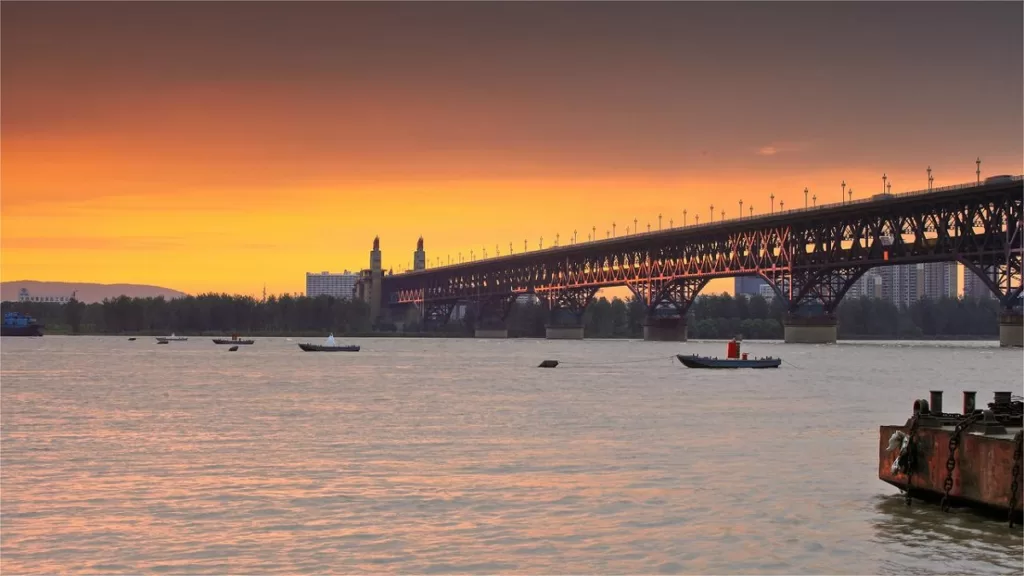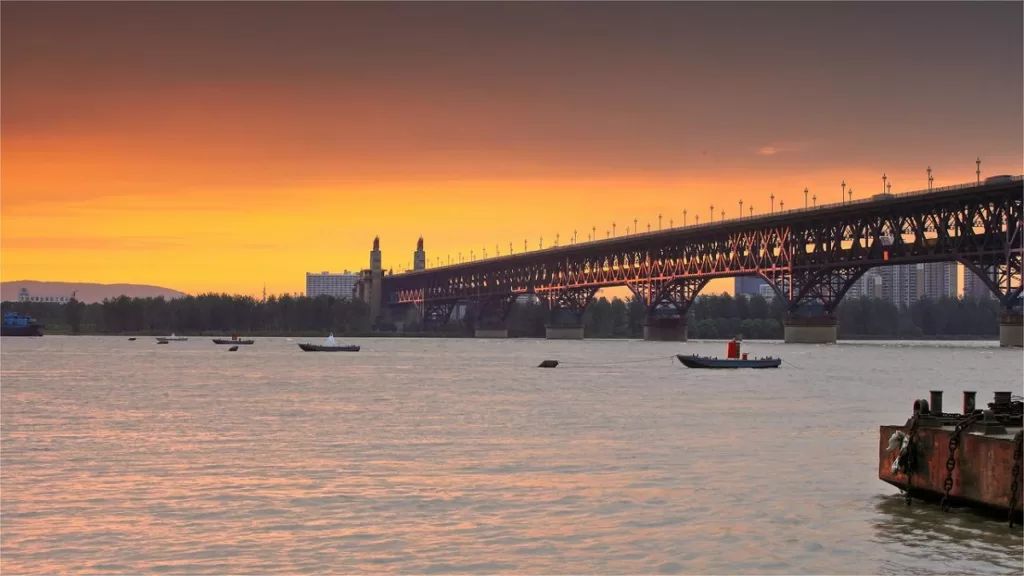Nanjing Yangtze River Bridge - Ticketpreis, Öffnungszeiten, Lage und Highlights


Spanning the mighty Yangtze River in China, the Nanjing Yangtze River Bridge (南京长江大桥) stands as a testament to human ingenuity, engineering excellence, and the nation’s unwavering determination. With a history that stretches back over half a century, this iconic structure has become an integral part of China’s modern identity and a symbol of national pride.
Inhaltsübersicht
- Grundlegende Informationen
- Standort und Transport
- Geschichte
- Remarkable Features
- Enduring Significance
- Vlog about Nanjing Yangtze River Bridge
- Nützliche Tipps aus Rezensionen zusammengefasst
- Attractions Near Nanjing Yangtze River Bridge
Grundlegende Informationen
| Geschätzte Dauer der Tour | 1 Stunde |
| Ticketpreis | Kostenlos |
| Die Öffnungszeiten | 24 Stunden am Tag, 7 Tage die Woche |
| Telefon Nummer | 0086-025-85822475 |
Standort und Transport
The Nanjing Yangtze River Bridge is strategically positioned to facilitate transportation and connectivity in the region. It is an integral part of the national highway system and serves as a crucial link for both road and rail traffic. The bridge’s location allows for the smooth flow of goods, people, and ideas between different parts of China, contributing to economic growth and cultural exchange. To get there, you can choose the following ways:
Bus: Take bus 530, 532, 535, 538, 539, 551, or 555 and get off at the Nanjing Yangtze River Bridge North. Or you can also take these buses to cross the bridge.
Metro: The nearest metro station to the Nanjing Yangtze River Bridge is Mufu West Road on line 7. After getting out of the station from Exit 3B, walk about 400 meters to the west to reach the bridge.
Geschichte
Construction of the Nanjing Yangtze River Bridge began in 1960 and was completed in 1968. At the time of its completion, it was the third bridge to be built across the Yangtze River, but it held the distinction of being the first bridge to connect the eastern and western parts of China. Designed by a team of Chinese engineers led by the renowned architect Professor Zhaohua Wang, the bridge represented a significant engineering challenge due to the treacherous river currents, changing water levels, and the need to accommodate large ships passing beneath it.
Remarkable Features
The bridge stretches an impressive 6,772 meters (4.2 miles) from end to end, making it one of the longest bridges in the world. Its main span is an astonishing 1,576 meters (1 mile), making it the longest single-span suspension bridge at the time of its completion. The bridge consists of two 320-meter-tall towers that support the main cables, which in turn support the deck. The deck is made up of a six-lane highway, accommodating both vehicular and pedestrian traffic.
The construction of the Nanjing Yangtze River Bridge was not just an engineering feat; it was a testament to the collective spirit and determination of the Chinese people. Tens of thousands of workers toiled tirelessly, braving challenging conditions and overcoming numerous obstacles to bring the bridge to fruition. It was a project that captured the imagination of the nation and became a symbol of China’s aspirations for progress and development.
Enduring Significance
Beyond its impressive technical specifications, the Nanjing Yangtze River Bridge holds great cultural and historical significance. It has witnessed the transformation of China over the years, serving as a vital link between the eastern and western regions of the country. The bridge facilitated the movement of people, goods, and ideas, contributing to the economic growth and cultural exchange between different parts of China. It has played a crucial role in the development of Nanjing, the capital of Jiangsu Province, and has become an iconic landmark in the city’s skyline.
Moreover, the Nanjing Yangtze River Bridge carries deep emotional resonance for the Chinese people. It has witnessed moments of triumph and tragedy, resilience and unity. During the construction period, many workers lost their lives, and their sacrifice serves as a poignant reminder of the human cost involved in building such monumental structures. The bridge has also been the site of important historical events, including significant celebrations, commemorations, and national parades.
Over the years, the Nanjing Yangtze River Bridge has undergone several renovations and upgrades to ensure its structural integrity and adapt to evolving transportation needs. The bridge has withstood the test of time and remained a symbol of China’s progress and determination. It has become an iconic representation of the country’s remarkable engineering achievements and serves as an inspiration for future generations.
Vlog about Nanjing Yangtze River Bridge
Nützliche Tipps aus Rezensionen zusammengefasst
Avoiding Peak Times: It’s advisable to avoid visiting during holidays or peak hours as the crowds can be overwhelming. Choosing off-peak times will allow you to take better photos without too many people in the background.
Summer Sun Precautions: During the summer, be mindful of sun protection. There is limited shade, and it’s easy to get sunburned. Ensure you bring sunscreen and take precautions against the sun’s heat.
Self-Prepared Snacks and Water: There are no food vendors nearby, so it’s recommended to bring your own snacks and water. Pay attention to safety, especially if you’re enjoying the scenery by the riverside.
Transportation Note: In the past, there were buses stopping on Nanjing Yangtze River Bridge, but that is no longer the case. The only way to access the bridge is on foot.
Nearby Attractions: Explore other attractions in the vicinity, such as Yangtze River Bridge Park, Xiaguan Train Theme Park, Former Site of National Naval Hospital, Zhongshan Wharf, Railway Ferry Pier Ruins, Yangtze Finless Porpoise Observation Point, Former Site Park of National Capital Power Plant, etc. Plan your visit based on your available time and interests.
Attractions Near Nanjing Yangtze River Bridge

Zheng He Treasure Ship Park - Lebendige maritime Zivilisation der Ming-Dynastie

Yuejiang Tower – A Breathtaking Panormic View
Lokales Leben in Jiangsu, Nanjing Attraktionen